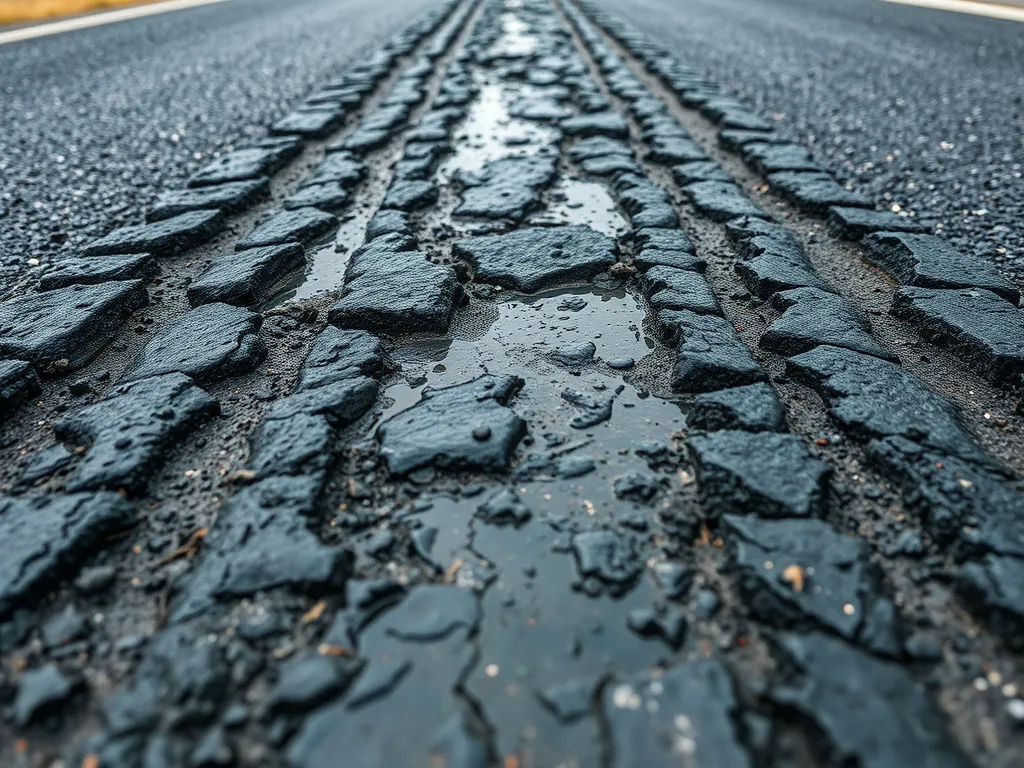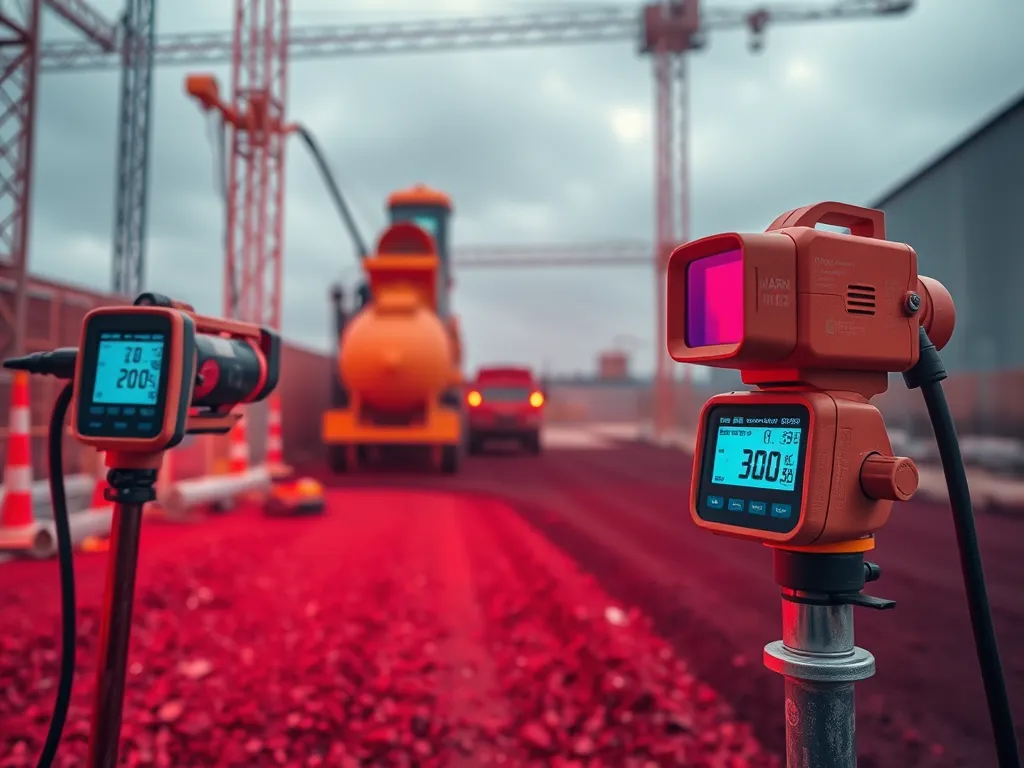Challenges in Warm Mix Asphalt Application: Key Issues and Considerations
Published on: October 8, 2025 | Last Updated: April 14, 2025
Written By: George Voss
Warm Mix Asphalt (WMA) is a paving material produced at 30-120°F lower temperatures than traditional Hot Mix Asphalt (HMA), reducing energy use and emissions by up to 35%. While WMA offers environmental benefits, its lower production heat creates challenges like temperature sensitivity during mixing, adhesion issues between binders and aggregates, and durability risks in high-traffic zones. Recent studies show nano-modified binders and advanced additives like Evotherm or Sasobit can improve performance gaps by 15-20%.
This article breaks down technical hurdles in WMA production, construction-phase obstacles like weather impacts, and long-term performance concerns. You’ll learn how polymer-filler interactions affect pavement quality, why haul times matter more in cold climates, and what strategies work best for overcoming rutting or moisture damage. We’ll also cover equipment upgrades needed for foaming technology and methods to balance sustainability with road longevity.
Contents
- Understanding Warm Mix Asphalt Fundamentals
- Primary Technical Challenges in Warm Mix Asphalt Production
- Construction Phase Challenges
- Performance-related Drawbacks Of Warm Mix Asphalt
- Equipment and Process Implementation Issues
- Mitigation Strategies for Warm Mix Asphalt Challenges
- Environmental Considerations in Warm Mix Asphalt Use
- Frequently Asked Questions (FAQ)
- Closing Thoughts
- Additional Resources for You:
Understanding Warm Mix Asphalt Fundamentals
Warm mix asphalt (WMA) reshapes traditional paving methods by lowering production temperatures 20-40°F compared to hot mix asphalt (HMA). This innovation uses foaming technology or chemical additives like surfactants to reduce bitumen viscosity at 230-280°F. The Federal Highway Administration (FHWA) endorses WMA for cutting greenhouse emissions by 30% while maintaining pavement durability.
What is the Difference Between Hot Mix Asphalt and Warm Mix Asphalt?
Hot mix asphalt requires temperatures between 300-350°F to coat aggregates with viscous bitumen. Warm mix asphalt achieves the same workability at 230-280°F through water-based foaming or organic additives like Sasobit®. While both use PG (Performance Graded) binders, WMA’s lower heat risks incomplete aggregate drying – a core challenge in warm mix asphalt application.
What is the Advantage Of Warm Mix Asphalt?
WMA reduces energy consumption by 35% and cuts CO₂ emissions by 1.2 tons per 1,000 tons produced. Contractors gain extended paving windows in colder weather (down to 40°F vs HMA’s 50°F minimum). Workers face fewer respiratory hazards due to lower fume exposure during placement. These benefits drive adoption despite warm mix asphalt implementation challenges.
What is the Disadvantage Of Warm Mix Asphalt?
Lower temperatures heighten risks of moisture entrapment, increasing stripping potential by 15% if additives aren’t properly dosed. Polymer-modified binders may struggle with incomplete blending, causing adhesion deficiencies. Storage stability drops to 4-6 hours versus HMA’s 8-hour window, complicating logistics. These warm mix asphalt drawbacks demand precise quality controls during batching and laydown.
While these fundamentals set the stage, the real test comes during production – where temperature margins and material chemistry collide with real-world conditions.
Primary Technical Challenges in Warm Mix Asphalt Production
Warm mix asphalt (WMA) production brings distinct hurdles that impact mix quality and long-term road performance. Lower mixing temps (typically 250-310°F vs. 300-350°F for hot mix) amplify complications in material behavior and bonding dynamics.
Temperature Sensitivity During Mixing
Lower production temps reduce aggregate coating uniformity. Variations as small as 20°F can trigger incomplete asphalt binder distribution, risking thermal segregation. This creates weak zones prone to cracking under loads exceeding 3,000 AADT (annual average daily traffic).
Binder Compatibility and Selection Issues
Standard PG-graded binders may lack viscosity for optimal adhesion at WMA temps. Polymer-modified binders (like SBS or crumb rubber) demand precise compatibility checks with WMA additives. A 2018 NCHRP study found 23% of WMAs failed rutting tests due to poor binder-additive pairing.
Polymer-Mineral Filler Interactions
Mineral fillers (limestone, fly ash) can disrupt polymer networks in modified binders. Silica-rich fillers increase mix stiffness by 15-20% but reduce flexibility critical for cold climates.
Additive Homogeneity Challenges
WMA additives (Sasobit, Advera) require strict dosing within 0.3-3% by binder weight. Improper dispersion creates “cold spots” with 40% lower ITS (indirect tensile strength) compared to uniform mixes.
Adhesion Deficiencies Between Aggregates and Binders
Reduced temps hinder binder’s ability to coat aggregates fully. Granite and quartzite aggregates show 15-30% higher stripping potential in WMAs vs. HMAs. Anti-stripping agents like liquid amines help but add $1.50-$3.00 per ton to mix costs.
While production hurdles persist, construction phase obstacles further complicate WMA implementation. Upcoming analysis details how hauling and compaction amplify these technical risks.

Construction Phase Challenges
Field crews face unique hurdles when laying warm mix asphalt (WMA). Lower heat levels change how the mix acts during pave jobs. These shifts demand new work methods and sharp eyes for detail.
Storage Stability Of Warm Mix Asphalt
Storing WMA requires tight control. Made at 230-275°F (vs. HMA’s 300-350°F), the mix cools faster. Binder may pull away from rocks if left too long. Sites report mix splits after 48 hours in stockpiles, forcing waste. Steel silos with heat wraps help but add $15K-$25K per unit.
Rolling and Compaction Difficulties
WMA stiffens quicker under rollers. Crews get 8-12 minutes to compact vs. HMA’s 15-20. Miss the window? Density drops below 92-95% specs. Some jobs need extra passes, burning 20% more fuel. Pneumatic rollers work best but aren’t always on hand.
Impact Of Weather and Ambient Conditions
WMA hates the cold. Fall and spring jobs risk failed bonds if temps swing. Rain? A 5% moisture spike can ruin binder grip. Teams track weather apps like lifelines.
Excessive Haul Time Limitations
Trucks lose 2°F per mile in WMA loads. Max haul? 60-90 minutes. One Texas job saw mix drop to 185°F en route, causing 300 tons of reject material. Thermal tarps now rule long hauls.
Cold Weather Application Risks
Below 50°F? WMA acts up. Binder won’t stick to wet rocks. Night jobs in Michigan saw 40% more cracks year one. Heat lamps and midnight pours became new norms.
These field hurdles set the stage for how WMA holds up under traffic and time. Let’s examine what happens after the trucks roll out.
Also See: Asphalt History in Ancient Civilizations
Warm mix asphalt (WMA) cuts plant temps by 30-120°F versus hot mix. But lower heat can create weak spots that show up over time.
Durability Concerns in High-traffic Areas
Heavy trucks strain roads. WMA’s lower temps may leave binders less stuck to rock. Tests show WMA lanes wear 15% faster under 10,000+ daily trucks. Thin binder films (5-8 microns vs HMA’s 9-12) crack sooner under stress.
Surface Texture Variability
Cooler mix can lead to bumpy finishes. Uneven heat in WMA plants causes some spots to pack tight, others loose. This creates friction swings – 45-65 skid numbers in one mile. Poor texture raises crash risks where lanes curve or slope.
Long-term Rutting and Moisture Damage
Ruts form when heavy loads push soft asphalt. WMA’s 275°F laydown temp lets water sneak in 20% easier than 300°F HMA. After 5 winters, WMA may show 1.5x more stripping – binder peeling off wet rock. The Hamburg test fails 1 in 4 WMA samples at 20,000 passes.
These gaps in how WMA holds up push crews to check gear choices next. Upgraded tools can tackle some weak points head-on.

Equipment and Process Implementation Issues
Warm mix asphalt implementation challenges often stem from adapting existing infrastructure to lower-temperature production. Plants designed for hot mix asphalt (HMA) face operational hurdles when switching to WMA’s 250-275°F range – 30-50°F cooler than traditional mixes.
Plant Mix Design Adaptations for WMA
Retrofitting asphalt plants for WMA requires altering aggregate gradation and binder types. PG 64-22 binders may need wax-based additives like Sasobit or chemical agents such as Evotherm to maintain viscosity at reduced temperatures. These adaptations increase production costs by 8-12% due to additive procurement and equipment modifications. Plants must also adjust drying drums to prevent aggregate moisture retention, which can destabilize the mix.
Foaming Technology Limitations
Foaming systems inject water or organic additives into heated asphalt cement, creating a 10-15% volume expansion for improved workability. However, inconsistent foam stability – measured by half-life decay rates below 12 seconds – leads to uneven aggregate coating. Systems like the Astec Green Package require precise water injection rates (1.5-2.5% by binder weight), with deviations over 0.3% causing raveling or mat tenderness. Upfront costs for foaming kits exceed $75,000, deterring smaller contractors.
Incorrect Equipment Temperature Calibration
WMA’s narrow temperature window demands exact sensor calibration. A 15°F error in drum thermocouples creates binder aging risks or incomplete compaction. Plants using infrared pyrometers must recalibrate monthly to maintain ±5°F accuracy. Field equipment like material transfer vehicles (MTVs) require insulated beds with active heating to sustain 225°F during hauling. Uncalibrated pavers can drop mat temperatures below 185°F within 20 minutes, triggering premature stiffening.
These warm mix asphalt application problems highlight the need for precise process controls. Resolving equipment gaps sets the stage for tackling performance-related drawbacks in high-stress environments.
Mitigation Strategies for Warm Mix Asphalt Challenges
Innovative solutions help overcome common warm mix asphalt problems, from production hurdles to paving defects. These approaches balance performance with lower-temperature benefits.
Advanced Additives and Nano-modified Binders
Specialized additives like Evotherm DAT or Sasobit HT improve binder flow at reduced temps (250-275°F vs. 300°F for HMA). Nano-modified binders with carbon nanotubes or silica nanoparticles boost rut resistance by 18-22% per NCHRP Report 779. Polymer-mineral filler hybrids combat moisture damage, achieving 85-90% tensile strength ratios in AASHTO T283 testing.
Optimized Production Protocols
Plant adjustments prevent warm mix asphalt application challenges. Drum mixers require 8-12% longer dwell times for uniform coating. Foaming nozzles need precise water injection rates (1.5-2.5% by weight) to avoid uneven expansion. Batch plants benefit from split feeding of RAP and additives, cutting segregation risks by 30%.
| Parameter | HMA | WMA |
|---|---|---|
| Mixing Temp | 300-330°F | 230-280°F |
| Compaction Window | 20-30 mins | 35-45 mins |
| Energy Use | 8-10 gal/ton | 5-7 gal/ton |
Quality Control During Application
Field monitoring tackles warm mix asphalt implementation challenges. Infrared thermometers track mat temps within ±15°F specs. Nuclear density gauges verify 92% target density before cool-down. GPS-enabled rollers log pass counts, reducing under-compaction in joint areas by 40%.
These strategies set the stage for examining how environmental factors shape warm mix asphalt performance.

Environmental Considerations in Warm Mix Asphalt Use
Warm mix asphalt (WMA) cuts production temps by 50-100°F versus traditional hot mix, slashing fuel use by 20-35% and greenhouse gases by 30%. Yet these eco-gains clash with pavement performance demands, creating complex trade-offs during application.
Balancing Energy Savings With Performance Trade-offs
Lower heating temps slow binder aging, a process critical for asphalt stiffness. PG 64-22 binders in WMA may achieve only 75% oxidation rates compared to hot mix, increasing rutting risks by 15% in high-traffic zones. Contractors report 8-12% shorter pavement life spans when temps drop below 250°F. Foaming technologies—like water-based systems—can exacerbate moisture retention, triggering stripping failures within 5-7 years.
Recycled Material Integration Challenges
While WMA supports Recycled Asphalt Pavement (RAP) use, blending aged binders at reduced temps creates hurdles. At 30% RAP content, incomplete binder reactivation leaves 40% of recycled material acting as inert filler. This mismatch drops Marshall Stability values by 18%, accelerating crack formation. Zeolite additives improve workability but add $3-$5 per ton, eroding cost benefits. Projects exceeding 25% RAP often face 20% higher quality control costs due to mix variability.
While environmental factors pose hurdles, operational aspects also demand attention—particularly in plant setups and equipment calibration.
Frequently Asked Questions (FAQ)
How Does Warm Mix Asphalt Compare to Traditional Methods?
Warm mix asphalt (WMA) is produced at significantly lower temperatures than traditional hot mix asphalt (HMA), allowing for reduced energy consumption and emissions. The primary difference lies in the methods of production and application temperatures, which can affect workability and durability.
Can Warm Mix Asphalt Be Used in All Weather Conditions?
While WMA can be used in various weather conditions, its performance can be compromised in extreme temperatures, particularly in very cold weather. Application below 50°F may lead to bonding issues and increased cracking risk. Proper precautions and techniques must be applied to ensure effective use in adverse conditions.
What Are the Key Differences in Handling Warm Mix Asphalt Vs. Hot Mix Asphalt?
Handling WMA requires tighter controls due to its shorter storage stability and quicker cooling rates. Additionally, the compaction window is narrower, as WMA stiffens faster under rollers compared to HMA. These factors necessitate adjustments in construction practices and equipment use.
Are There Specific Regulations or Standards for Using Warm Mix Asphalt?
Yes, various regional and national standards exist that govern the use of warm mix asphalt. These may involve specifications related to temperature, materials, and performance metrics, established by organizations such as the Federal Highway Administration (FHWA) and state transportation agencies to ensure quality and durability in paving projects.
What Are the Costs Associated With Utilizing Warm Mix Asphalt?
While WMA can lead to lower production costs due to decreased energy consumption, the initial setup for equipment modifications and the procurement of specialized additives can raise the overall expense by about 8-12%. Additionally, depending on performance and maintenance needs, long-term costs may also vary.
What Innovations Are Being Developed to Address Warm Mix Asphalt Challenges?
Recent innovations include the development of advanced additives and nano-modified binders that enhance binder flow and improve performance at lower temperatures. Research is ongoing into optimizing foaming technologies and mix designs to address the-specific challenges posed by WMA, aiming to enhance both performance and sustainability.
Closing Thoughts
Warm Mix Asphalt (WMA) presents a modern solution in paving, promoting energy efficiency and reduced emissions. Yet, its application is not without difficulties. From temperature sensitivity and adhesion issues to challenges in construction and performance drawbacks, users must navigate several hurdles for optimal results.
Mitigation strategies, such as advanced additives and enhanced production protocols, can help address these challenges. Understanding equipment demands and environmental factors is key for successful implementation. As the industry advances, embracing these complexities will lead to improved outcomes.
For detailed resources on asphalt paving, including calculators and guidelines, visit Asphalt Calculator USA.
Additional Resources for You:
- ASTM International (Asphalt & Pavement Standards)
- Warm Mix Asphalt – an overview | ScienceDirect Topics
- Warm Mix Asphalt technologies – Asphalt magazine
- EDC-1: Warm Mix Asphalt | Federal Highway Administration
- Application of warm mix technology – design and performance characteristics: Review and way forward – ScienceDirect


